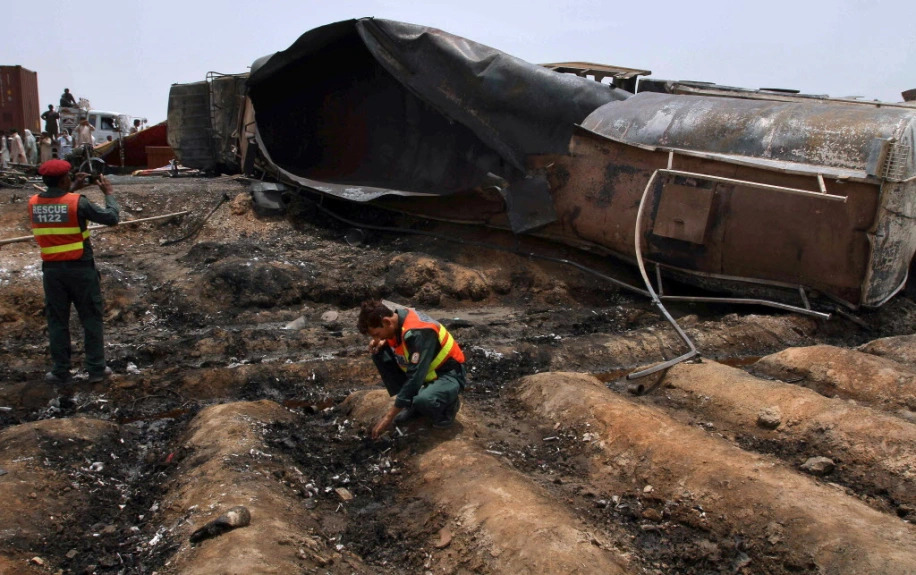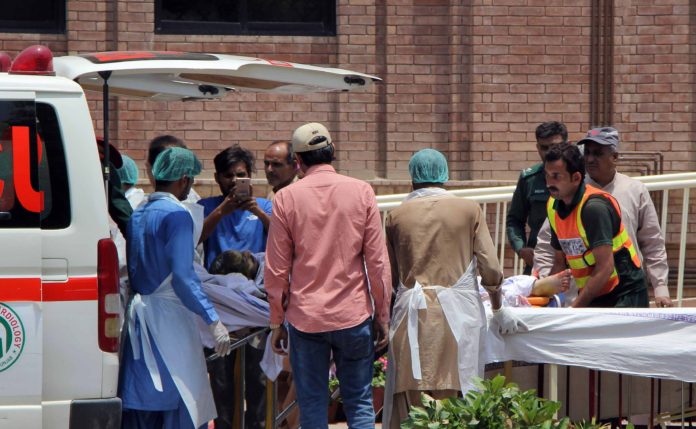On June 25, a day before Eid, an oil tanker carrying 40000 liters of fuel from Karachi to Lahore overturned when a tyre punctured attempting a sharp turn near Bahawalpur. Oblivious of the danger, hundreds of people from surrounding localities, carrying pails, bottles and jerry cans rushed to the scene to collect the leaking petrol. Attempts by the Motorway Police to keep people away from the oil spill fell on deaf ears. The tanker exploding in a huge fireball resulted in 165 killed and over 200 injured, many are critical. Shifted to Victoria Hospital (where there is no Burns Unit) and Combined Military Hospital (CMH) Bahawalpur, the severely burnt were subsequently transferred to hospitals in Lahore, Multan and Faisalabad.
Almost all the teaching hospitals of the country, in Multan, Lahore Faisalabad, Bahawalpur, Rawalpindi, Peshawar and Karachi have Burns wards which are inadequate, providing only the basic treatments with a very high mortality rate. Despite years of funding by Baitul-Mal the enormous building housing the Burns Center at Jinnah Hospital, Lahore cannot cope with major burns without the necessary facilities. Was it premonition on Shahbaz Sharif’s part that he sent a very frustrated Principal (now retired) Mehmood Shaukat of Allama Iqbal Medical College, Jinnah Hospital, Lahore, to the PIMS Burns Center to devise improving of the facilities in Lahore?
Classified as first, second or third degree burns, depending on how deep and severe they penetrate the skin’s surface, first-degree burns affect only the epidermis, or outer layer of skin. The burn site is red, painful, dry, and with no blisters. Second degree burns involve the epidermis and part of the dermis layer of skin appearing red, blistered, and may be swollen and painful. Third degree burns destroy the epidermis and dermis and may go into the subcutaneous tissue, the burn site may appear white or charred. Fourth degree burns damage the underlying bones, muscles, and tendons, with no sensation in the area since the nerve endings are destroyed.
According to the protocols of the “International Society of Burn Injuries”, admission criteria for the Burns Center require (1) Third degree burn greater than 5% BSA (body surface area) in any age group. (2) Second and third degree burns greater than 10% BSA of patients under 10 or over 50 years of age. (3) Second and third degree burns greater than 20% BSA in other age groups. (4) Second and third degree burns which involve the face, hands, feet, genitalia, perineum and major joints. (5) Electrical burns including lightning injury. (6) Chemical burns. (7) Inhalation burns injury. (8) Burns injury in patients with pre-existing medical disorders that could complicate management, prolong recovery or affect the mortality. (9) Burn patients with concomitant trauma pose the greatest risk of morbidity or mortality. Depending upon level of trauma, the patient may be treated at trauma center until stabilized and transferred to the Burns Center.
Three levels of burn care facilities include (1) Burn Ward as a basic facility in any general surgery or plastic surgery ward. (2) Burn Unit as an isolated ward with basic facilities to treat minor to moderate burns. (3) Burns Center as a State-of-the-art facility with dedicated staff to address all sorts of major burns. Personnel in the Armed Forces, especially those in the Armoured Forces, are susceptible to severe burn injuries, Burns Centers exists at CMH Kharian, NESCOM Islamabad and POF Wah but for defense personnel. Treatment is expensive, for non-authorized civilians it can cost Rs. 1 lac (0.1 million) a day.

A 20-bedded high-tech state-of-the-art Burn Care Center (BCC) was inaugurated by the President of Pakistan at the Pakistan Institute of Medical Sciences (PIMS) on December 6, 2007. Established in accordance with the latest international standards for the management of Acute Burn Care, this the only facility of its kind till date in the public sector of Pakistan. During the last 10 years this Center has managed more than 77000 patients with recovery rate comparable to such centers of the developed world. With separate rooms for each patient with special burn beds and latest monitoring equipment’s, the Center has in accordance with international standards (1) one nurse one patient ratio i.e. three nurses in 24 hrs. for one patient (2) two state-of-the-art modular operation theaters (introduced first time in Pakistan) with Laminar flow 100% clean air with latest HVAC system (3) Dialysis Unit with CRRT, an Endoscopy unit, an express laboratory, a blood bank, Skin Bank, latest Central gases supply system, CSSD, laundry, kitchen and physiotherapy/rehabilitation center and (4) latest showering units and hydrotherapy pools with hydraulic patient transfer trolleys.
Free of cost treatment to all patients for acute burn care in PIMS includes transplantation of synthetic skin and usage of Bio-dressings. Many advanced techniques and materials require synthetic skin and biological dressings to manage acute burns. With referrals from other cities increasing manifold, many admissions are denied because of non-availability of beds. From Jan 1, 2008 to Dec 31, 2016 76999 patients were seen out of which 3918 were admitted. 2908 patients recovered (74%) while mortality rate was 26% (1010 patients). Significance of establishing a specialized basis facility can be appreciated from the mortality rate, for 51-60% burns in USA it is 7% in PIMS 12% and in other public hospital 90%. For 41%-50% in USA it is 5% in PIMS 10% and in others 86%. For 30-40% in USA it is 2%, in PIMS 4% and in others 70%.
Prof Dr. Tariq Iqbal, the outstanding doctor who got the PC-1 approved for this first State-of-the-art unit in the public sector in August 2003, has been associated with PIMS Burns Center since its establishment in 2008. He prepared the technical specifications in consultation with the relevant experts. Project Coordinator since 2008, he got the project completed successfully within the stipulated time and allocated budget. For observation and training Dr Tariq has visited various international Burns Centers in the Netherlands, UK and the US. As Chair/Head/Director of the Burns Unit, this committed person has dedicated himself entirely for above par management of burn victims.
With billions being invested in building motorways and highways, no real emergency services exist along the arterial routes of Pakistan. What ignited the fuel is irrelevant, the paucity of expertise and equipment to cope with such emergencies is what needs urgent remedial measures. What would happen in a nuclear event? To save lives the treating of major burns must start in the first “golden hour”, only possible with regional Burn Centers established on an emergency basis in major cities throughout the country.




